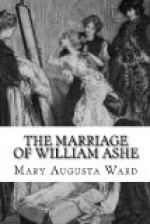IX
“Wasn’t I expected?” said Darrell, with a chilly smile.
“Oh yes, sir—yes, sir!” said the Ashes’ butler, as he looked distractedly round the drawing-room. “I believe her ladyship will be in directly. Will you kindly take a seat?”
The man’s air of resignation convinced Darrell that Lady Kitty had probably gone out without any orders to her servants, and had now forgotten all about her luncheon-party—a state of things to which the Hill Street household was, no doubt, well accustomed.
“I shall claim some lunch,” he thought to himself, “whatever happens. These young people want keeping in their place. Ah!”
For he had observed, placed on a small easel, the print of Madame de Longueville in costume, and he put up his eye-glass to look at it. He guessed at once that its appearance there was connected with the fancy ball which was now filling London with its fame, and he examined it with some closeness. “Lady Kitty will make a stir in it—no doubt of that!” he said to himself, as he turned away. “She has the keenest flair of them all for what produces an effect. None of the others can touch her—Mrs. Alcot—none of them!”
He was thinking of the other members of a certain group, at that time well known in London society—a group characterized chiefly by the beauty, extravagance, and audacity of the women belonging to it. It was by no means a group of mere fashionables. It contained a large amount of ability and accomplishment; some men of aristocratic family, who were also men of high character, with great futures before them; some persons from the literary or artistic world, who possessed, besides their literary or artistic gifts, a certain art of agreeable living, and some few others—especially young girls—admitted generally for some peculiar quality of beauty or manner outside the ordinary canons. Money was really presupposed by the group as a group. The life they belonged to was a life of the rich, the houses they met in were rich houses. But money as such had no power whatever to buy admission to their ranks; and the members of the group were at least as impatient of the claims of mere wealth as they were of those of mere virtue.
On the whole the group was an element of ferment and growth in the society that had produced it. Its impatience of convention and restraint, the exaltation of intellectual or artistic power which prevailed in it, and even the angry opposition excited by its pretensions and its exclusiveness, were all, perhaps, rather profitable than harmful at that moment of our social history. Old customs were much shaken; the new were shaping themselves, and this daring coterie of young and brilliant people, living in one another’s houses, calling one another by their Christian names, setting a number of social rules at defiance, discussing books, making the fame of artists, and, now and then, influencing politics, were certainly helping to bring the new world to birth. Their foes called them “The Archangels,” and they themselves had accepted the name with complacency.




